Generally speaking, there are two types of fibers: those that support multiple propagation paths or transverse modes are called multi-mode fibers (MMF), and those that support a single mode are called single-mode fibers (SMF). But what is the difference between them? Reading this article will help you get the answer.
Overview Of Single Mode Vs Multimode Fiber Optic Cable
Single mode fiber allows the propagation of only one light mode at a time, while multimode optical fiber can propagate multiple modes. The key differences between them are in fiber core diameter, wavelength & light source, bandwidth, color sheath, distance, cost, etc.
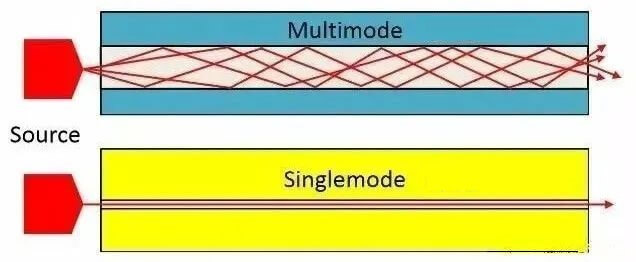
Single Mode Vs Multimode Fiber, What Is The Difference?
Time to compare single mode vs. multimode optical fiber and understand their differences.
Core Diameter
Single Mode cable has a smaller core size, typically 9μm, enabling lower attenuation, higher bandwidths, and longer transmission distances.
In contrast, Multimode optical fiber has a larger core size, usually 62.5μm or 50μm, with OM1 at 62.5μm and OM2/OM3/OM4/OM5 at 5μm. Although there is a difference in size, it's not easily visible to the naked eve as they are smaller than a human hair's width. Checking the printed code on the fiber optic cable can help identify the type.
With a protective cladding, both single mode and multimode fibers have a diameter of 125μm.
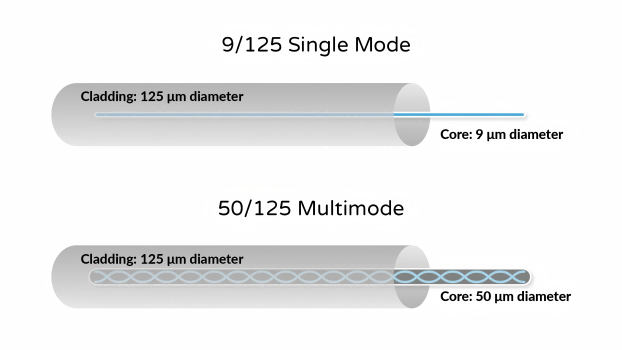
Wavelength & Light Source
Multimode optical fiber, with its large core size, uses low-cost light sources like LEDs light and VCSELs at 850nm and 1300nm wavelengths. In contrast, single mode cable with its smaller core, utilizes lasers or laser diodes to produce light injected into the cable, commonly at wavelengths of 1310nm and 1550nm.
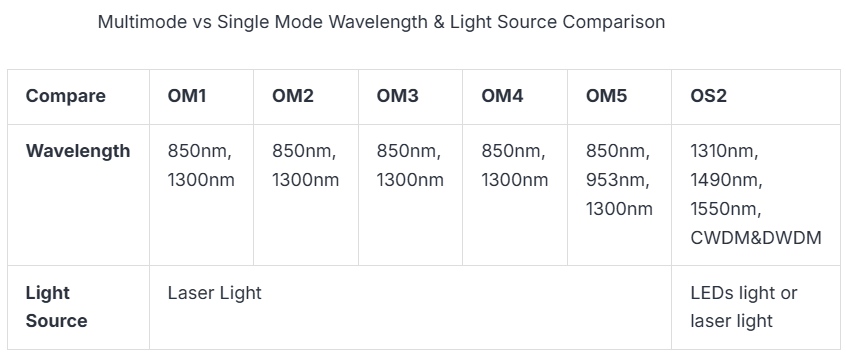
Bandwidth
These two fiber types differ in bandwidth capabilities. Single-mode fiber offers nearly unlimited bandwidth due to its support for a single light source mode, resulting in lower attenuation and dispersion. It is the preferred choice for high-speed telecommunications over long distances.
On the other hand, multimode fiber can transmit multiple optical modes, but it has higher attenuation and larger dispersion, limiting its bandwidth.
Single-mode fiber outperforms multimode optical fiber in terms of bandwidth capacity.
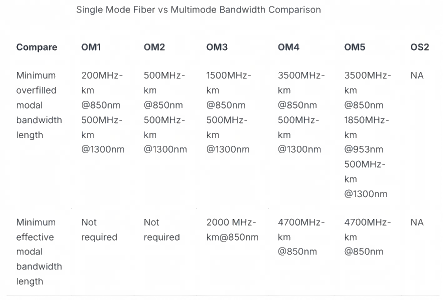
Attenuation
Single-mode fiber has lower attenuation, while multimode fiber is more susceptible to attenuation.
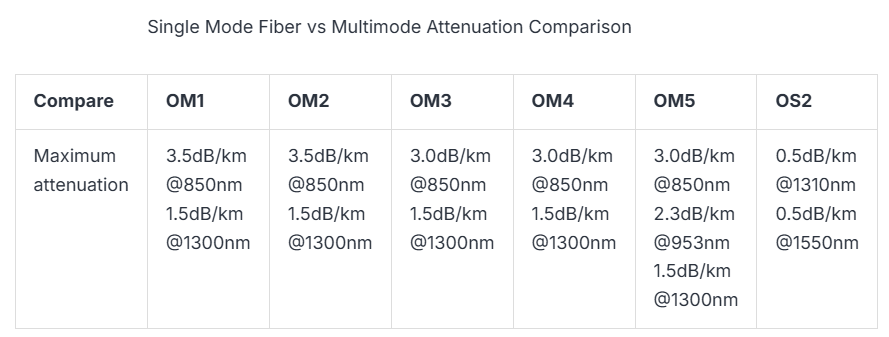
Distance
Single mode cable's lower attenuation and mode dispersion enable much longer transmission distances than multimode. Multimode is cost-effective but limited to short links (e.g., 550m for 1Gbps), while single mode is used for very long-reach transmission.
Cost
When considering the total cost, three segments play a crucial role.
Installation Cost
The installation cost for single-mode fiber is often perceived to be higher than multimode cable due to its advantages. However, the reality is the opposite. thanks to more efficient manufacturing, saving 20-30% compared to multimode fiber. For the pricier OM3/OM4/OM5 fibers, single-mode can save up to 50% or more. However, the optical transceiver cost must also be taken into account.
Optical Transceiver Cost
The optical transceiver is a significant cost component in fiber cabling, accounting for a substantial portion, sometimes up to 70% of the total cost. Single mode transceivers generally cost 1.2 to 6 times more than multimode ones. This is because single mode utilizes high-power laser diodes (LD), which are more expensive, while multimode devices typically use lower-cost LEDs or VCSELS.
System Upgrade Cost
With the rapid advancement in technology, cabling systems often require upgrades and expansion. Single mode fiber optic cabling offers greater scalability, flexibility, and adaptability. Multimode cable, due to its limited bandwidth and short distance capabilities, may struggle to meet future demands for long-distance and high-volume signal transmission.
Upgrading a single mode fiber optic system is more straightforward, involving only changing the switch and transceivers without the need to lay new fibers. In contrast, for multimode cable, upgrading from OM2 to OM3 and then to OM4 for higher-speed transmission would incur significantly higher costs, especially when changing the fibers laid under the floor.
In summary, multimode is cost-effective for short distances, while single mode is ideal for medium to long distances.
Color
Color coding simplifies cable type identification. TlA-598C provides the industry's suggested color code for easy recognition.
Multimode OM1 and OM2 usually have the orange jacket.
OM3 usually have Aqua color jackets.
OM4 usually have Aqua or Violet color jackets.
OM5 was colored lime green.
Single mode OS1 and OS2 typically with Yellow jackets.
Application
Single mode cable is primarily used in long-distance backbone and metro systems in telecom, datacom, and CATV networks.
On the other hand, multimode cable is mainly deployed in relatively short-distance applications such as data centers, cloud computing, security systems, and LANs (Local Area Networks).
Conclusion
In conclusion, single-mode fiber cabling is ideal for long-reach data transmission in carrier networks, MANs, and PONs. Multimode fiber cabling, on the other hand, is more commonly used in enterprise, data centers, and LANs due to its shorter reach. The key is to choose the fiber type that best fits your network requirements while considering the total fiber cost. As a network designer, making this decision is crucial for an efficient and reliable network setup.
Post time: Jun-19-2025

